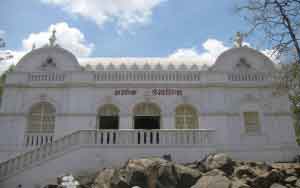Prelude
Junagadh, was the capital of the Junagadh state, under the muslim rulers of Babi Nawabs. In Gujarati " Junagadh " literally means ancient fort. The Junagadh town is located at the foothills of the sacred hill of Girnar and occupies a special place in the history of Gujarat. The history of Junagadh is chequered by the rules of the Mauryans, Kshatrapas, Guptas, Vallabhis, Chudasamas, Gujarat Sultans and Babi Nawabs. Junagadh, at different times in history, was under the influence of four major religions : Hindu, Buddhist, Jain and Muslims. Both political powers and religious influences enriched the culture and created fantastic edifices leaving their mark on the architecture of Junagadh.
Places of interest

-Ashoka's Rock Edicts
Fourteen Rock Edicts of the Emperor Ashoka can be seen inscribed on a great boulder. These ancient inscriptions date back to 250 BC and carry Brahmi script in Pali language. Late Sanskrit inscription were added around 150 AD by Rudrakama and in about 450 AD by Skandgupta. The inscriptions were reported in 1822 by Todd, but really came to light only in 1837 when Rev.Dr John Wilson copied them and in 1843 when the Royal Asiatic Society published them in the Bombay branch journal. The 16 principals preach virtues like matery of the senses, purity of thought, gratitude, devotion, self control, secular thinking and kindness, while opposing animal sacrifice and greed. They speak of repentance for death and destruction caused during the wars waged by Ashoka.
-Gir nar Hill Rising up on the outskirts of Junagadh is Mt Girnar, whose 3660 foot high summit is crowned by some of the finest and religiously most important temples. The climb is a steep one and best undertaken in the very early hours of the morning. The main entrance to the hill is in front of the Uparkot. On the hill top there are Jain and Hindu temples standing in a quadrangular courtyard. The main temple, which is surrounded by pillared cloisters containing 70 cells is dedicated to the 22nd Jain Thirthankara (God) Neminath. Further up from Neminath Temple, the Amba Temple is where newly married Hindu prays for a happy marriage.
-Mohabat Maqbara Maqbars - the older complex offers some remarkable 18th century architecture with vertical columns, delicate carved columns, arches, cornices & domes. The newer complex is a remarkable architectural work with four minarets & pirouetting spiral staircase, a facade rich in stone carvings, beautifull silver door & large size domes. A number of Haveli's are known for their jharokhas & wood carving - specimens of Gujarat doemstic architecture.
-Darbar Hall Museum Darbar hall museum dating back to 1870 a.d. offers an insight into the period of Nawabi rule in Junagadh with silver plated thrones, fine carpets, huge chandeliers & a red silk carpet with diamonds like stars of a crimson sky & some carpets lavishly embroidered with gold thread, huge chandeliers, royal armoury, potraits & paintings.
-Uparkot Fort Uparkot, an ancient citadel located on the higher level of the town, was a stronghold of Mauryans and Gupta Empire and is said to have survived 16 sieges in the last 1000 years due to its strategic location and difficult access. The entrance of Uparkot has a fine specimen of Hindu Toran, leading of flat land dotted with archeological sites. The major sites are Buddhist caves, Baba Pyara Caves (2nd century), Adi-Kadi Vav, Navghan Kuvo and Jami Masjid.
The Buddhist caves are fine examples of rock cut architecture with ornamented pillars, carved entrances, water cisterns, chaitya hall, monastic cells for meditation and chaitya windows. Adi-Kadi Vav and Navghan Kuvo were built by the Chudasama Rajputs and unique water structures among the numerous step wells of Gujarat. The Adi-Kadi Vav (15th century) has a long flight of 120 steps leading to water, while the Navghan Kuvo ( 1026 a.d) is hewn from the soft rock and is 52 meters deep, reached by a circular staircase winding around the shaft. Another intersting artefact from past is "Nilam" canon , brought to Diu from Egypt to fight against the Portuguese and it was manufactured by the order of Suleyman, the magnificent, King of Turkey.
-Junagadh Museum ( Sakkarbagh Museum ) Located in Sakkarbagh, the museum displays wonderful prehistoric and protohistoric stone and bone implements, stone sculptures including a standing vishnu of late 9th century, bronzes, minatures, manuscripts , stone and copper inscriptions, silverware, glass, porcelain, woodcarving, textiles and folk art.
How to reach The nearest airport from keshod is 40 km , from Porbander it is 113 km and from Rajkot 101 km
Climate The climate of Junagadh is characterized by dry wind and scanty rainfalls in summers and monsoon, respectively. It is best to explore this city between the months from October to March



